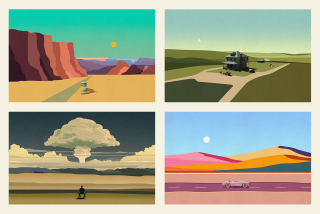Regarding the history of the American West,...
- Share via
Regarding the history of the American West, there’s the vision that the white people came in and wiped out the landscape, and there’s the vision that the landscape was empty and needed civilizing.
Which view is right?
Both and neither, according to Peter Blodgett, curator of Western American Manuscripts at the Huntington Library in San Marino. He has put together the library’s exhibit, “Paradise Found, Paradise Lost?: Conflicting Visions of the American West.”
“We’re trying to remind people that there’s a more complicated context,” Blodgett said. “We point out some of these matters as ways in which different people envisioned the potential of the West and the way in which these visions were at cross-purposes.”
For example, in the middle of the 19th Century, state and territorial governments, along with the transcontinental railroads, promoted the West as a vast agricultural paradise with plenty of free land available for homesteading.
Larger populations, the result of settlers moving in, would mean more commerce and industry, give territories the right to become states, and increase the railroads’
Engraving shows a view of the foot of the Rocky Mountains as they appeared in 1823.
markets.
However, the land turned out to be extremely arid and not all that good for traditional farming, not to mention the impact on the Plains Indians, who were displaced as a result.
“It’s also attempting to look at other peoples’ points of view,” Blodgett said. “The collections are heavily weighted towards the Anglo-American perspective, although we do try to introduce as many voices as we can.”
Such as the autobiography of Nat Love, a Black cowboy.
Blodgett pointed out that there were also Native American and Latino cowboys as well.
“We tend to remember (the West) in a limited number of stereotypical characters,” he said. “There are complicated dimensions to all of the stereotypes.”
The Huntington Library, 1151 Oxford Road, is open to the public Tuesday through Friday from 1 to 4:30 p.m. and 10:30 a.m. to 4:30 p.m. Saturday and Sunday. Admission is free, but a donation of $5 per adult is suggested.
More to Read
Sign up for our Book Club newsletter
Get the latest news, events and more from the Los Angeles Times Book Club, and help us get L.A. reading and talking.
You may occasionally receive promotional content from the Los Angeles Times.








